In the last two decades the attention for the environmental protection has been spread widely, especially in developed countries [1]. In particular, great efforts have been made to limit the global warming, in order to avoid serious consequences for mankind.
In this context, the Kyoto Protocol represents an important milestone, that entered into force on 16 February 2005. For the first time in history, most countries fixed the common goal of the restriction of carbon dioxide (CO2) emissions, in order to limit global warming [2]. In particular, the recent ratification of “Paris agreement” fixed the limitation of the global warming below 1.5 °C, imposing specific targets for each signatory state [3].
To satisfy the ever growing energy demand and achieve the environmental target, adoption of Renewable Energy Sources (RES) is fundamental [4]. The progressive diffusion of RES carries several benefits: reduction of the cost for electricity production, development of new and more efficient technologies, and limitation of energy dependence on fossil fuels [5].
The 2018 World Energy Outlook of the International Energy Agency (IEA) points out an increasing trend of the electricity demand [6]. Indeed, the world electricity demand is practically doubled in just two decades: 13,156 TWh were produced in 2000, while 22,209 TWh in 2017. This increase is essentially related to the developing countries, of which China has a dominant role [6].
About the energy sources, the share of conventional fossil fuels (oil, gas, coal) is almost stable (64.50% in 2000, 64.85% in 2017) but it is remarkable the progressive conversion of oil supplied power plants into gas supplied ones, due to the greater energy efficiency and lower CO2 emissions of these systems [7]. In the same period, the share of electricity production from RES has increased, from 18.72% to 24.88%.
Despite the availability of commercial technologies to exploit RES in an environmental friendly way, in several remote areas and small islands the electricity production is nowadays realized through obsolete plants, supplied by fossil fuels [8]. This approach causes negative effects for the environment, like the pollution of air [9], water and soil, as well as the generation of noise [10].
Furthermore, small islands normally do not have local fossil sources and for this reason fuels are shipped from the mainland. Bad weather conditions sometimes represent a real risk for the energy security of these territories. Rarely, long underwater cables connect the small islands to the mainland, since these projects require huge investments in comparison with local energy consumption [11]. For these reasons, the electrical power generation presents higher costs than in mainland [12].
The introduction of RES represents a valid alternative to the energy dependence on fossil fuel. This aspect is common in small islands around the world, with a relevance in the case of Small Islands Developing Countries (SIDS) [13]. There are limited exceptions, like Fiji and Dominica, where hydropower is used to cover a significant share of the local energy demand [14].
In any case, the fuel consumptions in SIDS implies the importation of fossil fuels from other countries. Trinidad and Tobago and Papua New Guinea are the only exception because these countries have local reserves [15].
Small island communities and in particular SIDS have in common the following peculiarities [16]:
Heavy reliance on imported fossil fuels;
Small-scale of the power plants used to produce electrical energy;
High operating and maintenance costs in the entire energy sector;
Limited use of the local renewable energy resources.
Unlike the small islands belonging to developed countries, SIDS are directly exposed to the international markets of oil, making the local economy fragile. Furthermore, in SIDS population and welfare show an increasing trend, implying a rapid growing of the energy demand. Finally, SIDS are generally located in the tropical zone [17], that is quite exposed to extreme weather conditions, causing disasters [18].
Recent statistics report that about 21 million people live stably in about 2,050 small islands, each one with a population ranging from 1,000 to 100,000 inhabitants [19].
These communities show an electrical energy consumption equal to 52,690 GWh/y, of which half is located in the Pacific Oceans [19].
As introduced before, in order to improve the energy sustainability of small islands, adoption of RES is fundamental [20].
Different RES mix have been proposed to supply several small islands around the world, as reported in the following case studies: Samsø (Denmark), Azores (Portugal), Skyros (Greek), Maldives, Canary Islands (Spain), Faroe Islands, Dongfushan Island and Reunion Island (France).
Samsø is a small Danish island, having a surface about 114 km2. It is electrically linked to the mainland [21]. Thanks to the installation of offshore wind turbines and biomass plants, since 1997 the community satisfies the electricity demand using exclusively RES [22].
Stenzel et al. [23] performed a Life Cycle Assessment (LCA), considering Graciosa Island as case study. This island belongings to Azores, an autonomous archipelago in the middle of the Atlantic Ocean. Since the local electricity production is based on fossil fuels, the realization of a RES mix is proposed, considering the installation of 4.5 MW of wind farm, 1 MW of photovoltaic panels (1 MW) and the existing diesel engines to balance the electrical grid and in case of energy backup.
Petrakopoulou [24] presented a hybrid power plant in order to satisfy the electrical demand of Skyros, a small Greek island, in the middle of Aegean Sea. The system is composed of solar thermal and photovoltaic plants, hydro and wind turbines.
Considering the Maldives Islands, Liu recommended the installation of a RES mix, composed of solar, wind and biomass sources [25]. To stabilize the electricity flow on the local grid, the modulation of the local desalination plant and diesel power plants is proposed.
About the Canary Islands, Rusu [26] reported a preliminary energy assessment suggesting the exploitation of sea wave energy and considering different technologies, currently in development step.
In the same context, Gils and Simon [27] reported several scenarios, considering a variegated energy mix composed by solar, wind, geothermal, biomass and hydro power as energy sources and development of the electrical grid.
Another case study is Faroe Islands, an autonomous country formed by 18 islands that are in the middle of the North Atlantic Ocean between Norway, Iceland and Scotland. The archipelago is home to 50,000 inhabitants, that require an electricity demand equal to 335 GWh/y [28]. To this purpose, the current energy mix is entrusted to fossil fuels (49%), hydropower (33%) and wind source (18%) [28]. With the goal of improving the sustainability of the energy sector, Katsaprakakis et al. [28] investigated the installation of a wind farm, photovoltaic panels and a pumping hydro plant.
Zhao et al. [29] proposed a renewable energy mix to supply Dongfushan Island, located in the eastern part of China. The system is composed by solar panels, wind turbines, diesel generators and a battery storage system. A genetic algorithm is used to minimize the life cycle costs and maximize the production of electrical energy by RES [29].
Finally, Selosse et al. [30] considered the Reunion Island, a French oversea island in the Indian Ocean, analysing different energy scenarios based on biomass, hydropower, wind, solar, geothermal, sea wave and the Ocean Thermal Energy Conversion (OTEC, i.e. the energy related to the thermal gradient between the surface water and deep water of the sea) [31].
As reported above, the literature reports several examples of RES mixes to supply small islands. Wind and solar are the most popular solutions. Sometimes, geothermal, hydropower and biomass are also considered. Rarely, other new RES are investigated like sea wave and OTEC, since there are no commercial technologies for their exploitation [32], despite their important energy potential [33].
A few years ago, two decrees have been issued in Italy with the goal to increase the sustainability of the energy sector in small islands, proposing the installation of power plants supplied by RES and the improvement of energy efficiency in the final users. In particular, the decree of 14 February 2017 issued by the Italian Ministry of Economic Development considers 20 small islands and indicates for each one the current energy demand, the targets of electricity and thermal energy production from RES by 31/12/2020 and the financial incentives [34]. The comparison of the current installed power and the goals fixed by the decree is reported in Figure 1.
Share of RES and current installed power (data in kW) in small Italian islands
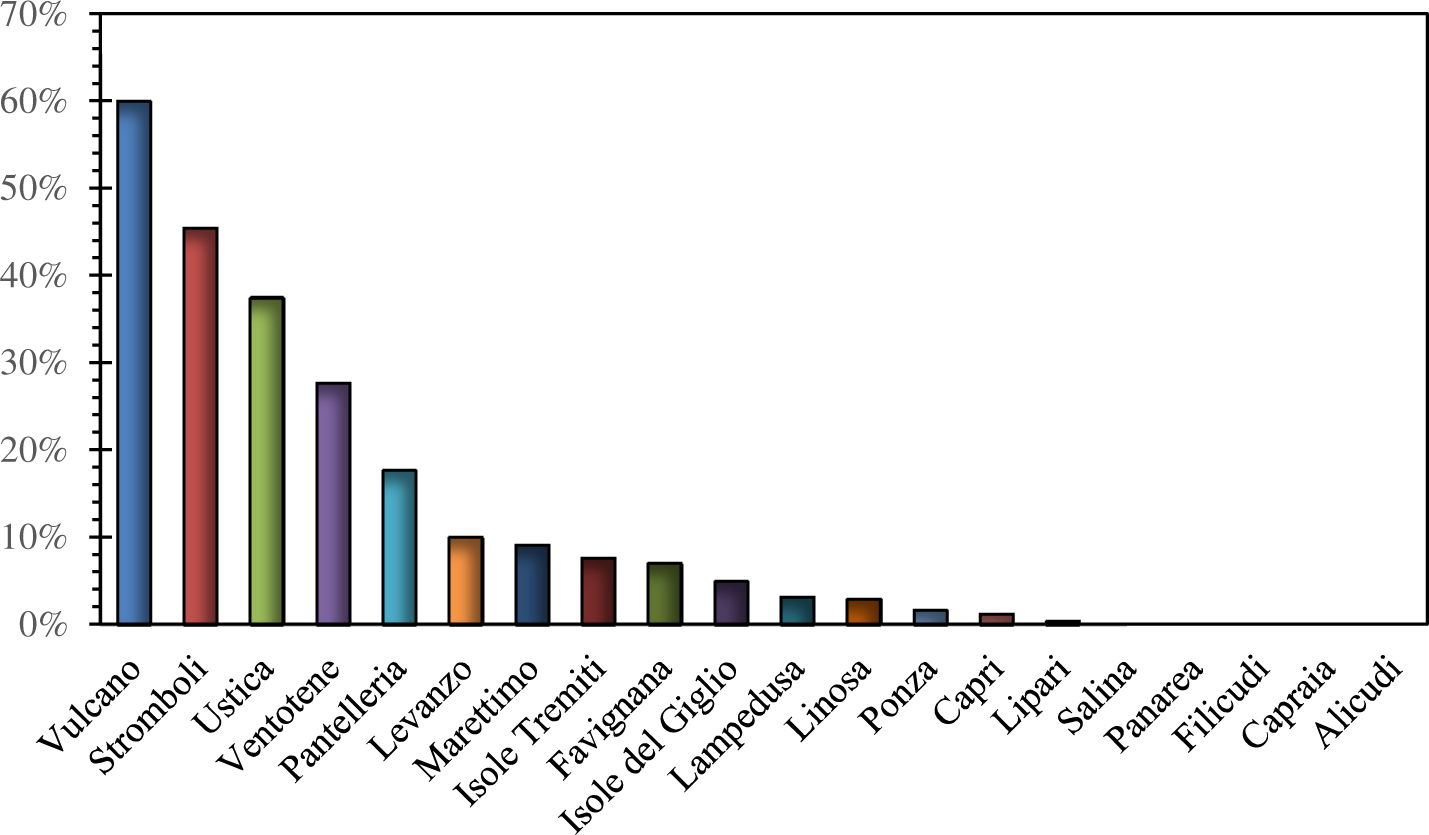
It is relevant that most small Italian islands are included in environmental protection programs, therefore the installation of land-consuming technologies or solutions with high visual impacts (like wind turbines) may not be feasible [35].
About the promotion of the energy efficiency in final users, the recent decree 340 released on 14 July 2017 by the Italian Ministry of Environment, Land and Sea earmarks 15 million euros to realize specific projects in 21 small Italian islands [36].
In the context of small islands, the paper suggests a sustainable energy mix, based on solar and sea wave. This energy mix can be successfully adopted in the several small islands of the Mediterranean Sea, because they have many points in common, such as size, availability of energy sources, climatic conditions, population density and environmental restrictions.
Despite the wind source that is available in small Italian islands, this contribution is nowadays absent since the installation of this kind of plants has been hindered by the environmental restrictions to preserve the landscape [35]. It should be remembered that currently no offshore wind farm is installed along the entire Italian coastline, despite recent approval of a project for a 30 MW wind farm to be built near to Taranto, an area deeply impacted by industrial activities in the past decades [37]. In many small islands, like in the case study reported below, the sea depth is quite high close to the coastline, making it complex to install fixed structures in offshore areas [38]. Photovoltaic panels can be installed, but only on the roofs of buildings that do not have historical and artistic values [35]. It is also important to underline that the decree of 14 February 2017, above introduced, never suggests the exploitation of wind energy, while the utilization of solar energy for the solar cooling and the production of domestic hot water is proposed. Innovative technologies are also encouraged, suggesting also the exploitation of sea energies [34].
For these reasons, new solutions should be investigated in order to supply the small islands. In this context, sea wave is considered a very promising RES for the next future [39], especially for islands [40]. Different studies have been realized in order to identify the best sites for the exploitation of this energy source [41].
Many solutions have been proposed for sea wave exploitation, but no commercial systems are available [42]. The Engineering Department of the University of Palermo is designing an innovative device for this purpose.
Indeed, the wave energy converter reported in this paper can be installed in an offshore area, limiting the visual impact. As better described in the following sections, this system is essentially composed of a two-floating buoys system, having a shape similar to a marking buoy [43].
The main advantage of this system is the limited number of components used in the energy conversion chain. The mechanical energy of sea wave is firstly collected by the floating buoy, then is transformed directly into electricity by linear generators [44]. Finally, an electronic power converter is used to regularize the electrical output [45].
The main goal of the paper is the realization of a preliminary energy assessment, in order to demonstrate the feasibility of the proposed energy mix for the application in small islands. A limited amount of climatic data is required by the model. Climatic data and cost information are obtained from literature or using a specific software.
In this context, the paper considers the small island of Ustica as case study, analysing the electrical energy demand of public buildings and facilities. In order to satisfy this electrical load, the authors propose a renewable energy mix based on solar and sea wave energy sources.
With the goal to increase the energy sustainability in small Italian islands, the paper presents a preliminary energy assessment, considering sea wave and solar radiation as energy sources. In this section, the technologies selected to produce electricity are presented. A simplified mathematical model is reported.
In this subsection, the authors present the Wave Energy Converter (WEC), i.e. the technology selected to produce electricity from sea wave. About the exploitation of solar radiation, some data of the chosen photovoltaic panels are reported.
The device here presented is called “DEIM Point Absorber”. It is under development at the Department of Engineering of the Palermo University [46]. The target of this machine is the exploitation of sea wave energy potential in the Mediterranean Sea, since there are several islands that need a more sustainable energy mix to supply the local electricity demand.
The system consists of two coaxial floating buoys, having different functions. The external buoy (yellow in Figure 2) is used to capture the mechanical energy of wave, producing a vertical motion that is transferred inside the central buoy (green in the picture) through a connecting rod. In this way, thanks to the axial geometrical symmetry, the device can extract energy from sea wave motion regardless of the wave direction. For this reason, this device is classified as Point Absorber [47].
The central buoy is equipped with a cylindrical weight installed in the lower part, in order to increase the inertia and the hydrodynamic resistance of the central buoy, limiting its vertical movement. Furthermore, the central buoy is fixed on seabed, using a long chain with a jumper buoy and four moorings. This solution is adopted to avoid potential damage to the seabed.
The energy conversion is based on linear generators, installed inside the central buoy, in this way the device converts directly the mechanical energy of wave into electricity with high energy efficiency, without the use of intermediate energy vector, such as pressurized fluids, or motion converters, like toothed wheels, transmission belts or freewheels.
External view of the DEIM Point Absorber
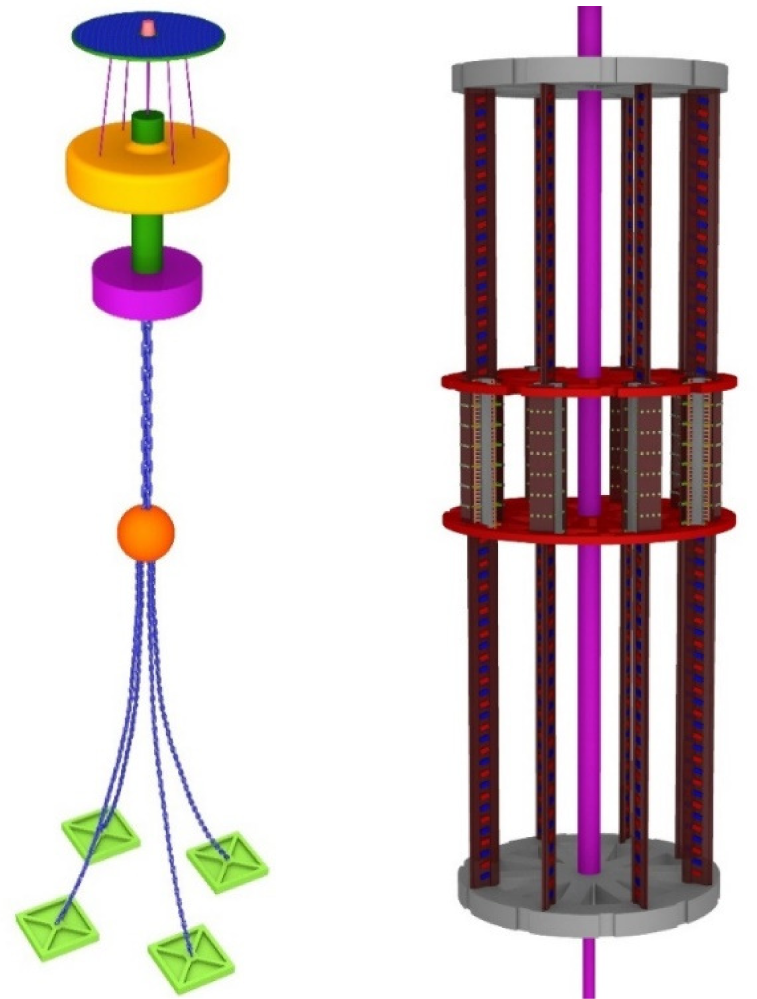
Focusing the attention on the central buoy, WEC contains inside eight linear generators, as shown in Figure 2. Each generator has a rated power of 10 kW, so the overall installed power is equal to 80 kW. The sizes of the conversion device have been chosen in order to optimize the electrical energy production according to the wave climate in the Mediterranean Sea. Each electrical machine is composed of two parts: the translator and the stator. The first is bound to the connecting rod, in order to introduce the vertical motion inside the electrical machine. Along each stator, 132 neodymium iron boron magnets are installed, alternating the magnetic poles. This solution avoids the need of an excitation current to produce the magnetic field, necessary for the power generation.
The stator is the fixed part, anchored to the inner frame of the central buoy. The stator of each electrical generator is composed of two symmetrical parts, in laminated iron. The stator contains the coils where the generation of electricity occurs.
As regards the sizes of DEIM Point Absorber, the external buoy has a diameter of ten meters, while the internal one has a diameter of two meters. The working stroke of the linear generators is about four meters: so, the WEC can produce electrical energy also in bad weather conditions. Additionally, most of the conversion device is located under the sea level, minimizing the visual impact [44].
Above the DEIM Point Absorber, a photovoltaic plant can be installed in order to exploit also the solar source (about 64 m2 of solar panels). In this way the device presents a more regular production during the year: in fact, the solar source shows greater values of solar radiation during the summer season, while the sea wave source is stronger during winter.
Furthermore, photovoltaic panels should be also installed on the roofs of existing buildings, excluding heritage constructions or houses with landscape restrictions.
In both case, commercial photovoltaic panels are considered. The datasheet is reported in Table 1 [48].
Main parameters of photovoltaic panels
| Model | PV-MLU255HC |
|---|---|
| Number of cells per panel | 120 |
| Maximum power rating [WP] | 255 |
| Open circuit voltage [V] | 37.8 |
| Short circuit current [A] | 8.89 |
| Module efficiency [%] | 15.4 |
| Dimensions [mm] | 1,625 × 1,019 × 46 |
| Weight [kg] | 20 |
In this subsection the mathematical approach is reported. The goal is the evaluation of the monthly electricity production from solar and sea wave energy sources.
Eq. (1) is used to calculate the monthly electrical production from solar panels installed on the roofs of public buildings:
(1)
indicating with the monthly solar radiation to an inclined surface to the south with a tilt angle equal to the latitude, represents the net area of photovoltaic panels installed above the public buildings, is the average electrical efficiency of photovoltaic panels and finally, represents the number of photovoltaic plants [49].
As introduced before, the DEIM Point Absorber is able to produce electricity using both sea wave and solar sources. To perform the evaluation of the monthly electricity production from the photovoltaic panels installed on the WEC, eq. (2) is introduced [49]:
(2)
considering the monthly solar radiation to a horizontal surface, the net area of photovoltaic panels installed in each DEIM Point Absorber , the electrical efficiency of photovoltaic panels and the number of devices installed in the solar wave energy farm .
The monthly electrical energy production from sea wave is evaluated considering the monthly average sea wave power flux , the equivalent hydraulic diameter of the external buoy of DEIM Point Absorber, the average electrical efficiency of the device, the number of hours in the i-th month and the number of wave energy converters [50]:
(3)
About the energy efficiency of the device, several tests have been performed on a small scale prototype [51].
To evaluate the environmental benefits, firstly the avoided electricity production from fossil fuels is obtained as sum of the monthly electrical energy production from sea wave and solar panels [see eq. (4)]. Multiplying this value with the specific emission factor , the annual avoided CO2 is obtained [see eq. (5)] [52]:
(4)
(5)
Finally, in order to evaluate the economic convenience of the project, the authors applied the discounted cash flow, expressed by eq. (6) [53]:
(6)
The equation considers the initial investment , the annual operating and maintenance costs , the annual income from the selling of electrical energy , the rate of interest for money (τ) and, finally, the rate of interest for energy (ε).
In this section the case study is presented. In the first subsection, the energy sector is investigated, reporting firstly some details about the climatic condition and the total electricity demand. Since the goal of the paper is the proposal of an energy mix to supply the public facilities, a more detailed analysis is reported below.
Ustica is a small Italian island, located in the Tyrrhenian Sea, about 67 kilometres north-west of Palermo (the biggest city of Sicily), as shown in Figure 3. The island covers an area of 8.65 km2, with a perimeter of 12 km.
Location of Ustica in the Mediterranean Sea
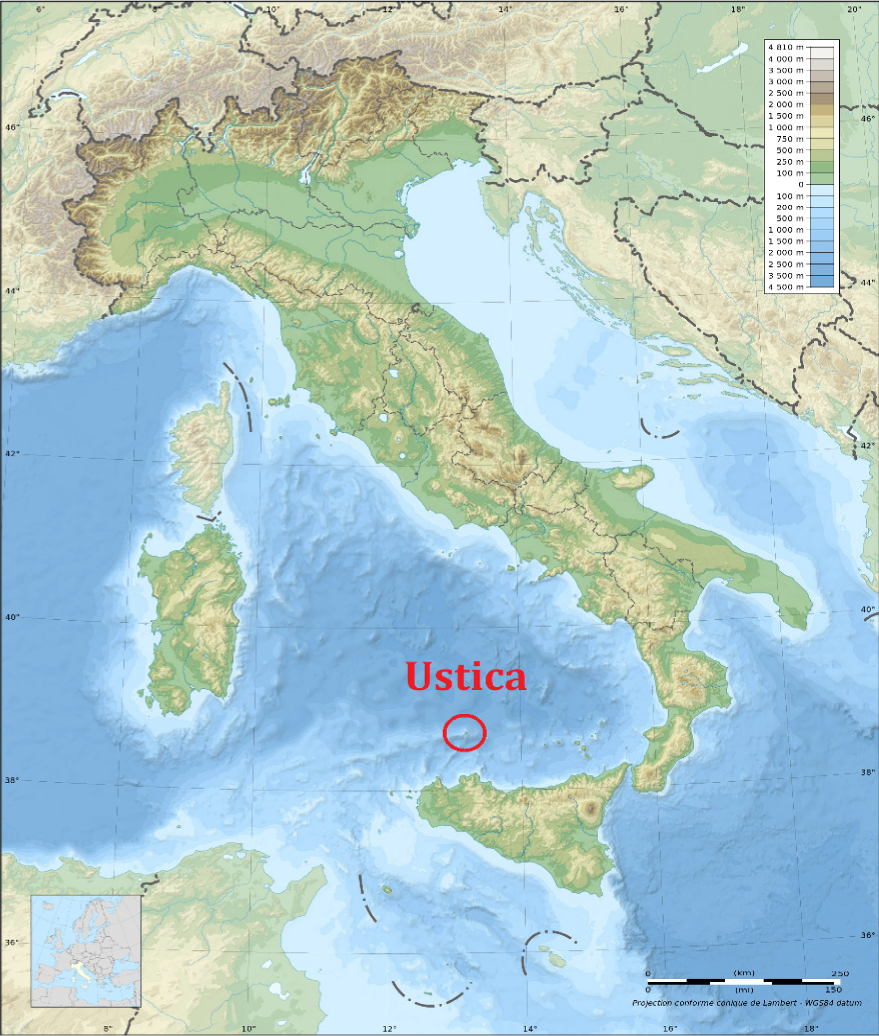
About 1,300 people live regularly on the island. Like most Mediterranean small islands, Ustica is equipped with a small electrical grid, not linked to the mainland. With regards to the transport, a ferry service is the only way to connect the island to the mainland.
The electrical production is entirely entrusted to old diesel engines, with an annual electricity demand equal to 6.5 MWh (data of 2015-2016). In Figure 4, the annual electricity demand is split into the main uses [54]. Almost the 82% of the total energy demand is due to three kinds of uses: residential (28.23%), desalination (29.10%) and other (24.59%, representing rural buildings and activities). The remaining electricity demand is related to specific activities, as public lighting, offices, hotels, tourist village, medical clinic and radar (for the national air traffic control).
Electrical consumption by uses
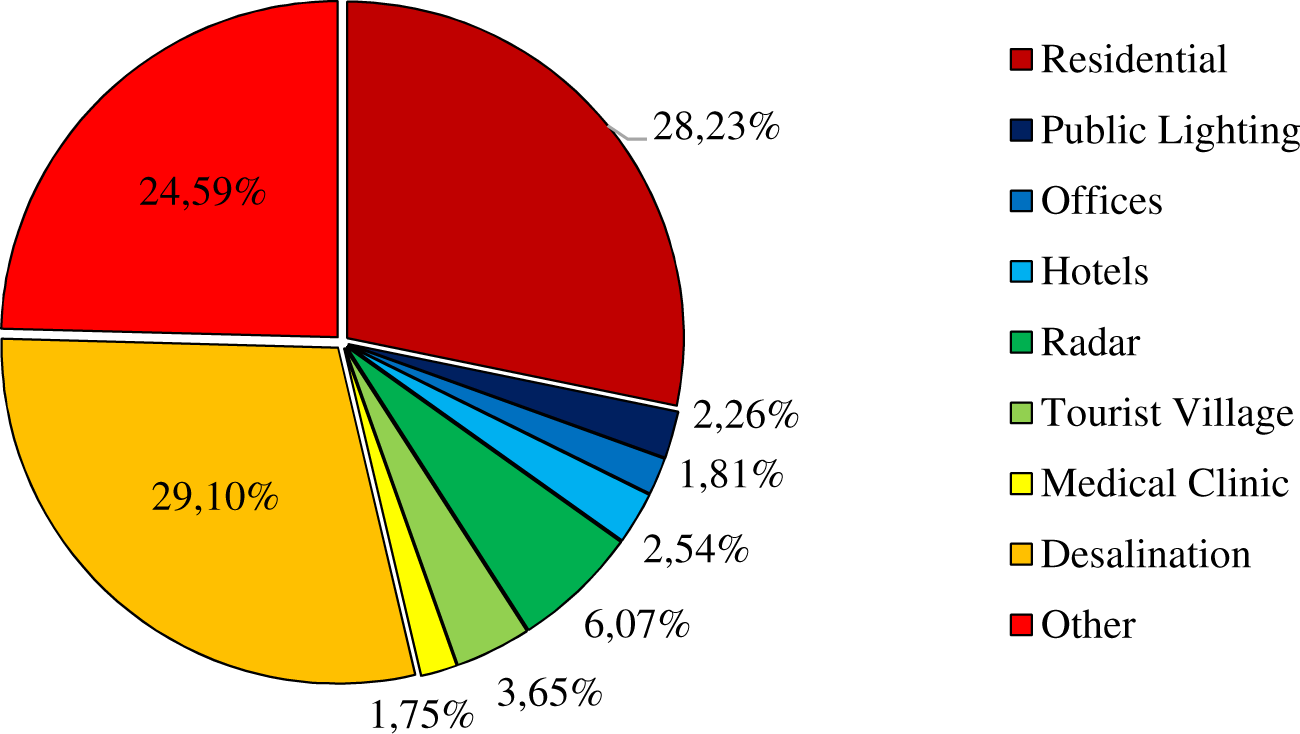
The annual trend (see Figure 5) of electrical energy consumption shows a significant variation during the four seasons: the maximum value is measured in August (1,028 MWh), while the minimum one is in February (377 MWh). This is due to the relevance of tourist sector, which represents the most important income for the island. The tourist arrivals are concentrated in summer (from June to September), therefore electricity and freshwater demands increase.
Annual trend of electricity consumption by uses
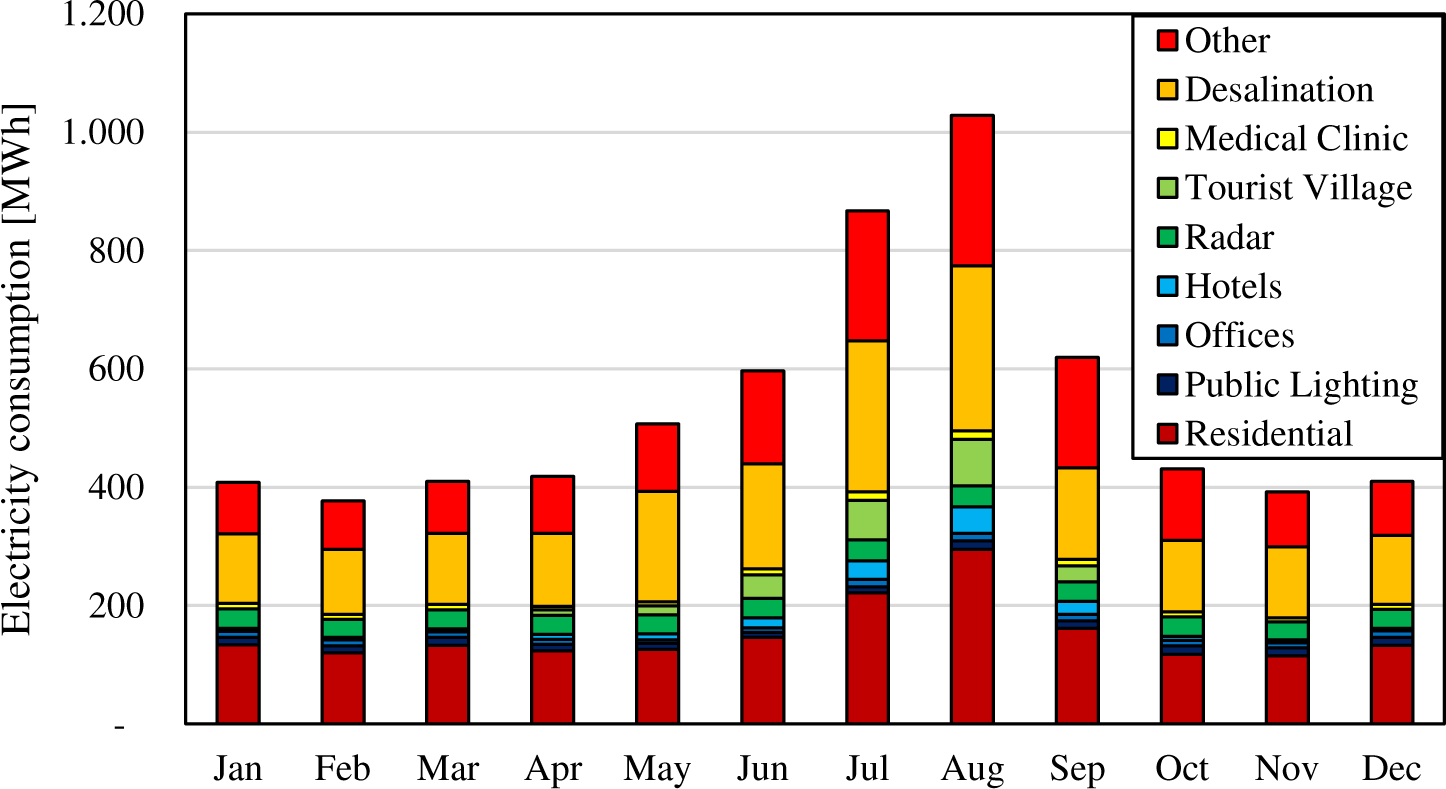
RES are practically unused, since the environmental constraints impede the installation of land consuming technologies, like photovoltaic panels (except the installation of building integrated photovoltaic systems) or devices visible at distance, like wind turbines [35].
In fact, the island of Ustica has two reserved areas (see Figure 6). The first one is the “Protected Marine Area”, established in 1986 and referred to about 16,000 hectares of sea around the island. This area is divided in three zones, with different levels of restrictions: inside Area A any type of boats is not allowed, fishing is forbidden, bathing and snorkelling are permitted, inside Area B, it is forbidden to take any form of plant or animal life, boats and underwater activities are allowed, except fishing, finally inside the Area C, navigation and docking are allowed, professional fishing is permitted only after specific authorization [55]. In this area the installation of offshore wind turbines could be suitable according to the law restrictions, however, it is important to underline that in Ustica, sea depth increase quickly with the distance from the coastline, exceeding 100 m at 250 m from the coastline.
Protected areas in Ustica
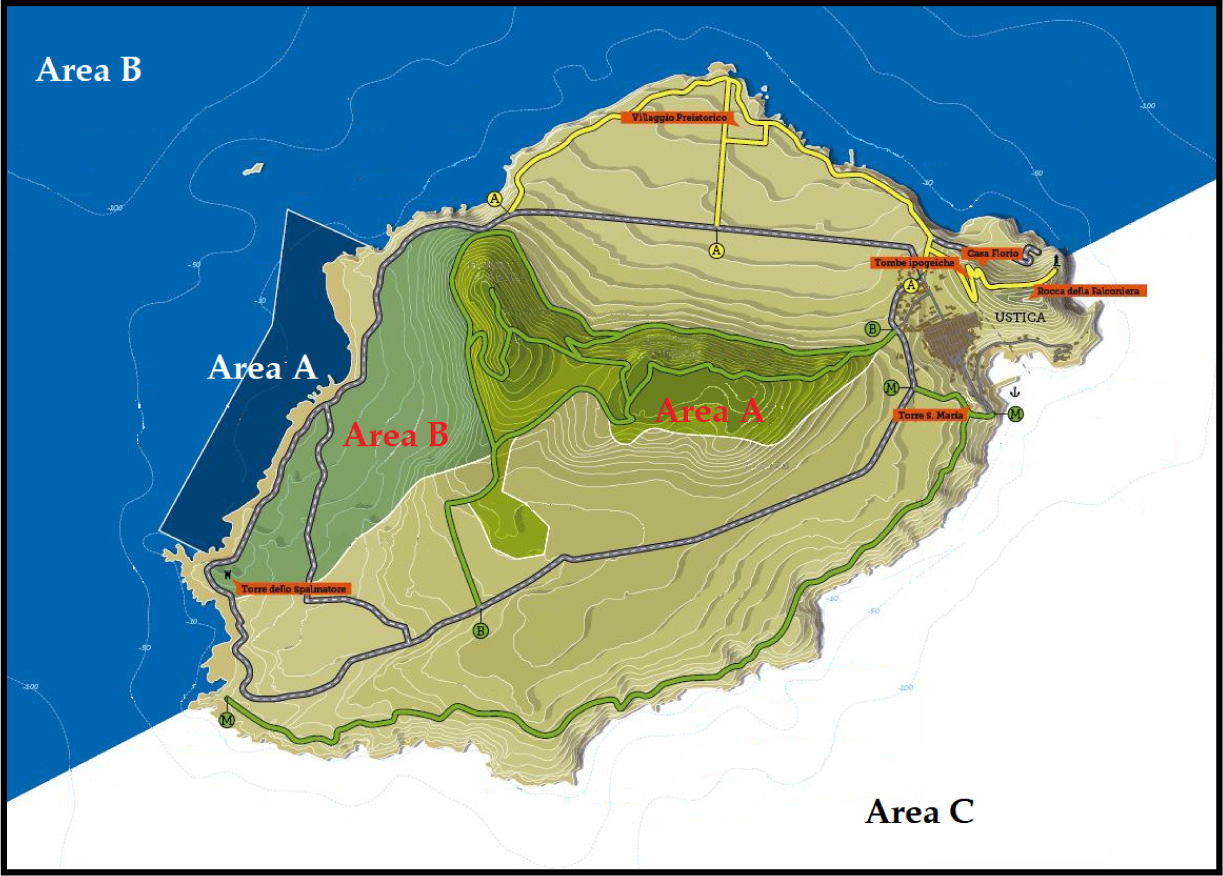
The latter reserved area is the “Terrestrial Natural Reserve”, established in 1997 and comprising about 500 species of terrestrial flora. Inside these areas all human activities are forbidden to preserve the local flora and fauna [56].
Ustica presents limited water reserves (lakes and rivers are absent). The only available natural source has a capacity of 350 m3/day, not enough to cover the freshwater demand of the island [57]. Thus, the greatest part of freshwater is produced by the desalination plant. In the past, freshwater was also transported by boat from the mainland in case of failure of the desalination plant.
In 2015, the desalination plant was updated, replacing the two old Mechanical Vapour Compression (MVC) units, with two more modern Reverse Osmosis (RO) units. The new plant has a nominal freshwater production equal to 72 m3/h [54].
In the previous configuration, the desalination plant was supplied by dedicated diesel engines. Due to the significant reduction of the electricity demand for desalination, the plant is currently supplied by the local power plant, modifying the load flows on the local electrical grid. The annual freshwater trend is reported in Figure 7 [54]. Considering also the electricity expenditure for water withdrawal from the sea, pre-treatments and post-treatments, the desalination plant produces freshwater with a unitary energy consumption equal to 5.91 kWh/m3.
Freshwater production by the desalination plant in Ustica
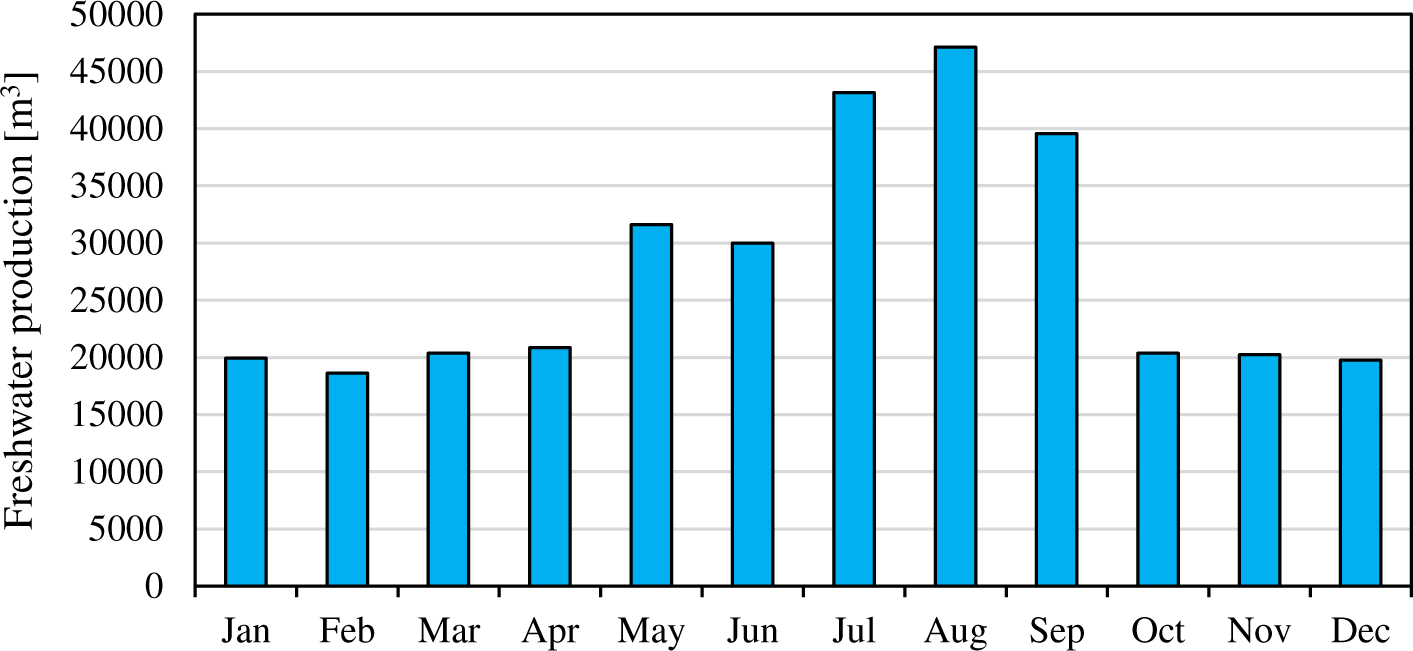
Like the electricity trend, the freshwater demand increases significantly during summer (about 47,000 m3 in August in comparison with 20,000 m3 during winter).
In Ustica there are several public services and offices, therefore the related costs to this electricity consumption are inserted in the budget of the municipality. For example, there are public schools, municipal offices, public lighting and water purification plants.
The following Table 2 reports the electrical consumptions in 2016 measured in the public buildings and facilities, subdivided in five categories: schools, public lighting, offices, water purification plant and other services.
Electrical consumption in public buildings and facilities in Ustica
| Annual electrical consumption [kWh/y] | Annual costs [EUR/y] | |
|---|---|---|
| Schools | 24,959 | 7,454 |
| Public lighting | 143,583 | 24,926 |
| Offices | 64,505 | 19,513 |
| Water purification plant | 67,126 | 15,014 |
| Other services | 16,667 | 9,730 |
Thus, according to the data reported in Table 2, the annual electrical demand from public services in Ustica is about 316,840 kWh/y, corresponding to a cost for the municipality equal to 76,637 EUR. The electrical consumption of public services represents only the 4.9% of the annual global electrical demand in Ustica.
In order to satisfy the energy demand for the public buildings and facilities in the island of Ustica, the authors suggest the following energy mix:
The installation of a small solar wave energy farm, composed of two DEIM Point Absorbers, able to exploit solar and sea wave sources, due to the integration of photovoltaic panels in the upper part of WEC;
The installation of photovoltaic plants on the roofs of public buildings, each one having a rated power of 3.3 kW.
The following Figure 8 shows the annual trend of sea wave power flux and the monthly solar radiation to a horizontal plane and an inclined plane to the south with a tilt angle equal to 39°. Data on sea wave are obtained from the “Rete Ondametrica Nazionale” that is the Italian measuring network composed of 15 buoys installed along the Italian coastline [40]. As regards solar radiation, an open source Geographic Information System (GIS) tool is adopted [58].
Data on solar and sea wave climate in Ustica
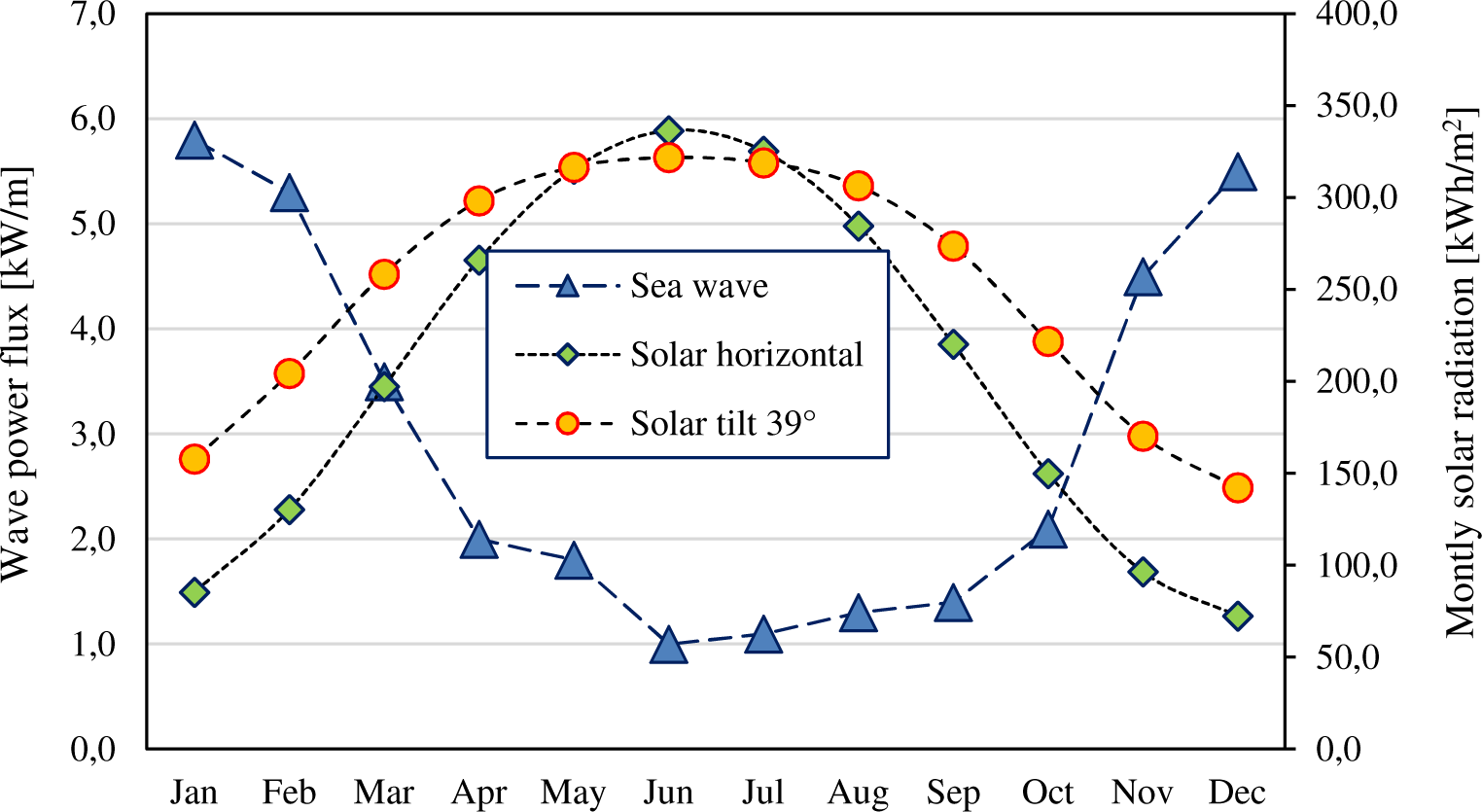
The energy mix is sized in order to cover the annual electrical demand of public services. Applying the set of equations reported above, Figure 9 shows the annual trend of the electrical energy production from the renewable energy mix proposed by authors.
Electricity production from the renewable energy mix
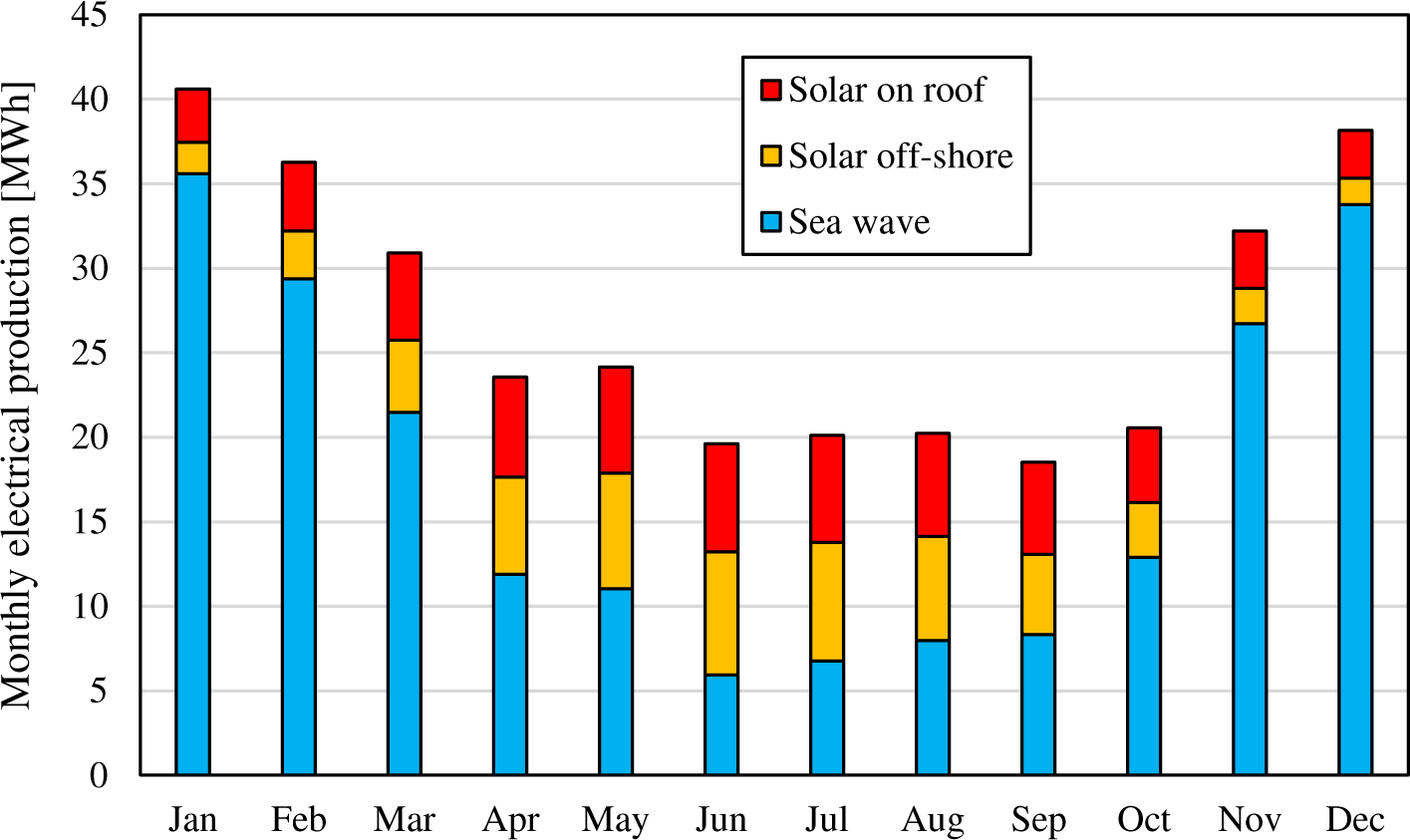
According to the simulations, the solar wave energy farm could produce 265.43 MWh/y, of which 211.76 MWh/y from sea wave and 53.67 MWh/y from solar. The installed power is equal to 160 kW from sea wave and 21.6 kW from photovoltaic panels.
In order to regularize the annual electrical production, as introduced before, additional photovoltaic plants must be installed on the roofs of public buildings. In particular, the authors assume the installation of 6 photovoltaic plants, each one having a rated power of 3.3 kW, with a global installed power of 19.9 kW. In this evaluation, the photovoltaic panels are oriented towards south with a tilt angle equal to the latitude of the site. In this way, the photovoltaic plants installed on the roofs of public buildings could produce 59.45 MWh/y.
Summing up all the energy production, the renewable energy mix proposed by the authors could produce 324.88 MWh/y, enough to cover the annual electrical demand of public service, with a small surplus equal to 8 MWh/y.
Obviously, the excess of production can be sold to the local electrical grid reducing the electrical production from fossil fuels.
The following Table 3 summarises the main data of solar wave energy farm, Table 4 reports the main data of photovoltaic plants that should be installed on the roofs of public buildings.
Details on the solar wave energy farm
| Parameters | Values |
|---|---|
| Number of buoys | 2 |
| Installed power by wave [kW] | 160 |
| Installed photovoltaic power [kW] | 21.6 |
| Annual electrical production by wave [MWh/y] | 211.76 |
| Annual electrical production by solar [MWh/y] | 53.67 |
Details on the roof-integrated photovoltaic plants
| Parameters | Values |
|---|---|
| Number of photovoltaic plants | 6 |
| Rated power of single photovoltaic plants [kW] | 3.3 |
| Installed power by photovoltaic plants [kW] | 19.9 |
| Annual electrical production [MWh/y] | 59.45 |
About the environmental benefits, the annual avoided CO2 emission was evaluated according to eq. (5). It assumes an emission factor equal to 0.682 t CO2/MWh, considering data from literature about similar technologies [52]. Thus, the proposed RES mix can avoid the emission of 221.6 t CO2/y.
Finally, the economic analysis was performed, evaluating the discounted cash flow according to eq. (6). All the economic parameters are reported in Table 5. About the cost for the installation and maintenance of photovoltaic panels, data are available in literature [5]. About sea wave, the authors investigated the cost of the device in a previous work [59].
Economic parameters used in the discounted cash flow
| Parameters | Values |
|---|---|
| Money discount rate [%] | 0.25 |
| Energy discount rate [%] | 2.0 |
| Initial investment [EUR] | 340,628 |
| Annual maintenance costs [EUR] | 37,469 |
| Selling energy price [cEUR/kWh] | 25.0 |
| Annual energy selling [EUR] | 81,221 |
It is interesting to underline that to cover the additional cost for the electricity generation in small islands, the Italian authority (ARERA) admits an incentivized price. Each small island shows a different value, equal to 41.39 cEUR/kWh in the case study, that should be summed to the average National Unique Price (NUP, 5.32 cEUR/kWh) [60]. Since the renewable energy mix should be installed by the local municipality, the authors considered a lower total price, practically equal to sum of the NUP and half of the incentivized price, in order to reduce the breakeven time and create a profit for the local and the national institutions. This value is close to the average price currently paid by the local municipality to purchase electricity.
The money discount rate is chosen according to the European Central Bank [61], while the energy discount rate is obtained analysing the trend of the NUP in the last five years [62].
Thus, considering the data reported above, the discounted cash flow was performed. As reported in Figure 10, the breakeven time is equal to 7 to 8 years.
Discounted cash flow of the project
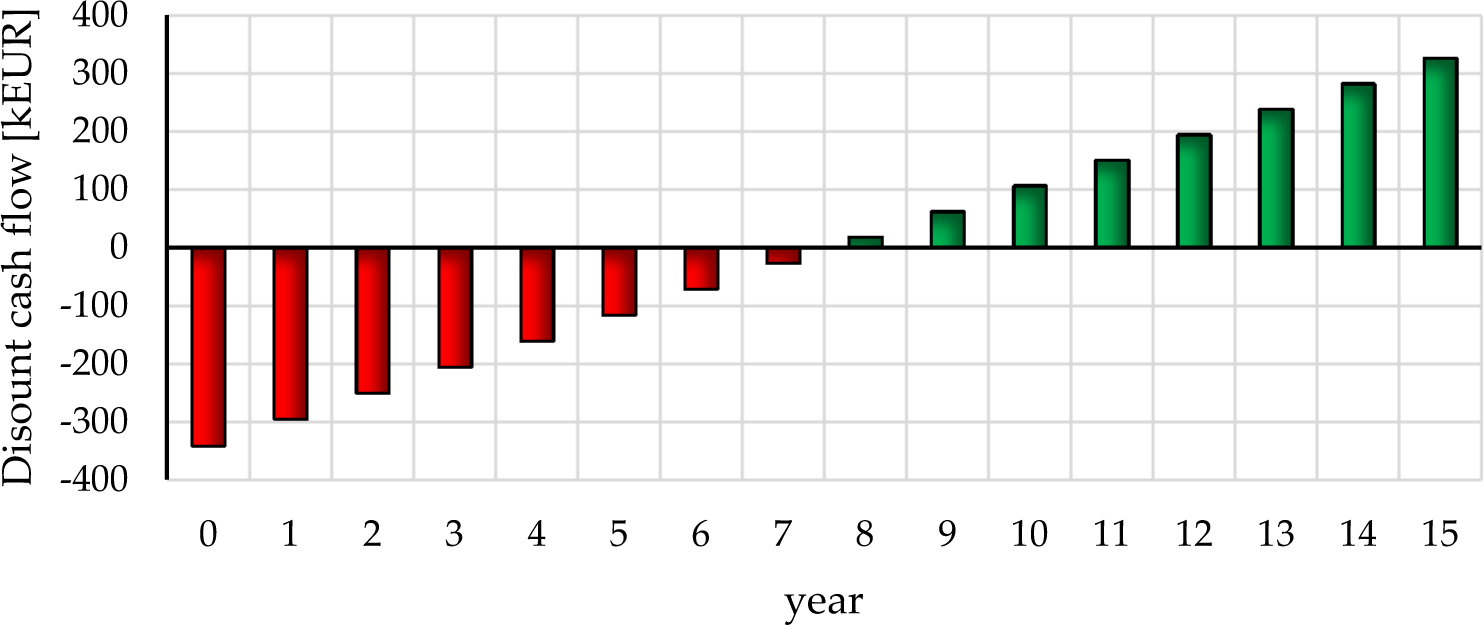
Small islands present a great renewable energy potential, usable to reduce progressively the energy dependence on fossil fuels. In particular, the sea wave source could be an interesting opportunity in the near future, thanks to its peculiarities like high energy concentration and limited visual impact of energy converters, in comparison with the technologies used for the exploitation of other renewable sources.
As introduced before, wind source is not considered in this work, because the environmental constrictions prohibit the installation of wind turbines. Furthermore, considering the regions outside of the marine reserved areas, the offshore application is not suitable in most small islands because the large depth of the sea. Thus, the proposed energy mix considers only solar and sea wave energy sources.
It is important to underline that these sources are affected by different trends during the year. Indeed, sea wave shows a peak of producibility during winter, while the solar radiation is stronger in summer. Thus, the adoption of these two sources is necessary to stabilize the electricity production during the year.
The case study of Ustica shows interesting results. The proposed energy mix includes two DEIM Point Absorbers, exploiting sea wave and solar sources at the same time, and six photovoltaic plants on the roofs of public buildings. The energy mix can produce enough energy to cover annually the electrical energy demand of public buildings and facilities, producing also a profit for the municipality, thanks to the selling of energy surplus and avoiding the purchase of energy from the local grid.
Considering the discounted cash flow, the authors estimate a breakeven time equal to 7-8 years. From an environmental point of view, the project could avoid the emission of 221.6 t CO2/y. Thus, these results encourage the realization of the project.
Finally, the authors wish remind that the analysis above reported has not considered the hourly balancing of the electrical grid, because the proposed energy mix is sized to cover only the energy demand for public services, which represent only 4.9% of the current electricity production of the local power plant. With this share of RES, the balancing problem of the grid could be managed by the modulation of the electricity production of the existing local power plant and the local desalination plant, considering the weather forecast of both sources [25]. Indeed, solar and sea wave are characterized by more regular trends than wind source.
In future works, a higher share of renewable energy source will be analysed, considering the hourly balancing problem of the electrical grid, the sizing of an energy storage system and the optimization of the energy flows.
- ,
A Preliminary Energy and Environmental Assessment of a Micro Wind Turbine Prototype in Natural Protected Areas ,Sustain. Energy Technol. Assessments , Vol. 8 ,pp 42-56 , 2014, https://doi.org/https://doi.org/10.1016/j.seta.2014.07.002 - ,
Public Spending on Renewable Energy in Italian Regions ,Renew. Energy , Vol. 115 ,pp 1086-1098 , 2018, https://doi.org/https://doi.org/10.1016/j.renene.2017.09.015 - ,
The European Union Possibilities to Achieve Targets of Europe 2020 and Paris Agreement Climate Policy ,Renew. Energy. , Vol. 106 ,pp 298-309 , 2017, https://doi.org/https://doi.org/10.1016/j.renene.2017.01.036 - , Renewable Energy Statistics, 2018
- , , Renewable Power Generation Costs in 2017, 2018
- , , World Energy Outlook 2018, 2018
- ,
The Impact of the Global Energy Transition on MENA Oil and Gas Producers ,Energy Strateg. Rev. , Vol. 26 , 2019, https://doi.org/https://doi.org/10.1016/j.esr.2019.100397 - ,
Integrating Clean Energy in Small Island Power Systems: Maldives Experience ,Energy Procedia , Vol. 103 ,pp 274-279 , 2016, https://doi.org/https://doi.org/10.1016/j.egypro.2016.11.285 - ,
The Combined Effect of Reduced Fossil Fuel Consumption and Increasing Biomass Combustion on Athens’ Air Quality, as Inferred from Long Term CO Measurements ,Sci. Total Environ. , Vol. 592 ,pp 115-123 , 2017, https://doi.org/https://doi.org/10.1016/j.scitotenv.2017.03.045 - ,
Uncertainty in Energy Planning: Estimating the Health Impacts of Air Pollution from Fossil Fuel Electricity Generation ,Energy Res. & Soc. Sci. , Vol. 6 ,pp 74-77 , 2015, https://doi.org/https://doi.org/10.1016/j.erss.2014.12.002 - ,
Renewable Energy in Pacific Small Island Developing States: The Tole of International Aid and the Enabling Environment from Donor’s Perspectives ,J. Clean. Prod. , Vol. 146 ,pp 29-36 , 2017, https://doi.org/https://doi.org/10.1016/j.jclepro.2016.05.011 - ,
Solar Energy for Sicily’s Remote Islands: On the Route From Fossil to Renewable Energy ,Int. J. Sustain. Built Environ. , Vol. 5 (1),pp 132-140 , 2016, https://doi.org/https://doi.org/10.1016/j.ijsbe.2016.04.003 - ,
Climate Proofing Island Energy Infrastructure Systems: Framing Resilience Based Policy Interventions ,Util. Policy , Vol. 55 ,pp 41-51 , 2018, https://doi.org/https://doi.org/10.1016/j.jup.2018.09.005 - ,
Energizing the Island Community: A Review of Policy Standpoints for Energy in Small Island States and Territories ,Sustain. Dev. , Vol. 14 (2),pp 139-147 , 2006, https://doi.org/https://doi.org/10.1002/sd.299 - ,
Small Island Developing States: Health and WHO: Country Presence Profile, Technical Document ,pp 13 , 2017 - , , Renewable Energy on Small Islands, 1998
- , , Transforming Small-Island Power Systems: Technical Planning Studies for the Integration of Variable Renewables, 2018
- ,
Small Island Developing States and Their Economic Vulnerabilities ,World Dev. , Vol. 23 (9),pp 1615-1632 , 1995, https://doi.org/https://doi.org/10.1016/0305-750X(95)00065-K - ,
Assessment of the Global Potential for Renewable Energy Storage Systems on Small Islands ,Energy Procedia , Vol. 46 ,pp 294-300 , 2014, https://doi.org/https://doi.org/10.1016/j.egypro.2014.01.185 - , , Renewable Energy Road Map: The Republic of Maldives, 2015
- ,
Islands “Smart Energy” for Eco-Sustainable Energy a Case Study “Favignana Island” ,Int. J. Heat Technol. , Vol. 35 (1),pp S87-S95 , 2017, https://doi.org/https://doi.org/10.18280/ijht.35Sp0112 - ,
How Does a Pioneer Community Energy Project Succeed in Practice? The Case of the Samsø Renewable Energy Island ,Renew. Sustain. Energy Rev. , Vol. 71 ,pp 884-897 , 2017, https://doi.org/https://doi.org/10.1016/j.rser.2016.12.116 - ,
Renewable Energies for Graciosa Island, Azores-Life Cycle Assessment of Electricity Generation ,Energy Procedia , Vol. 135 ,pp 62-74 , 2017, https://doi.org/https://doi.org/10.1016/j.egypro.2017.09.487 - ,
On the Economics of Stand-Alone Renewable Hybrid Power Plants in Remote Regions ,Energy Convers. Manag. , Vol. 118 ,pp 63-74 , 2016, https://doi.org/https://doi.org/10.1016/j.enconman.2016.03.070 - ,
Powering an Island System by Renewable Energy – A Feasibility Analysis in the Maldives ,Appl. Energy , Vol. 227 ,pp 18-27 , 2017, https://doi.org/https://doi.org/10.1016/j.apenergy.2017.10.019 - ,
Evaluation of the Wave Energy Conversion Efficiency in Various Coastal Environments ,Energies , Vol. 7 (6),pp 4002-4018 , 2014, https://doi.org/https://doi.org/10.3390/en7064002 - ,
Carbon Neutral Archipelago – 100% Renewable Energy Supply for the Canary Islands ,Appl. Energy , Vol. 188 ,pp 342-355 , 2017, https://doi.org/https://doi.org/10.1016/j.apenergy.2016.12.023 - ,
Faroe Islands: Towards 100% R.E.S. Penetration ,Renew. Energy , Vol. 135 ,pp 473-484 , 2019, https://doi.org/https://doi.org/10.1016/j.renene.2018.12.042 - ,
Optimal Sizing, Operating Strategy and Operational Experience of a Stand-Alone Microgrid on Dongfushan Island ,Appl. Energy , Vol. 113 ,pp 1656-1666 , 2014, https://doi.org/https://doi.org/10.1016/j.apenergy.2013.09.015 - ,
The Renewable Energy Revolution of Reunion Island ,Renew. Sustain. Energy Rev. , Vol. 89 ,pp 99-105 , 2018, https://doi.org/https://doi.org/10.1016/j.rser.2018.03.013 - ,
Ocean Energy, Renewable Energy Sources and Climate Change Mitigation, Special Report of the Intergovernmental Panel on Climate Change ,pp 497-534 , 2011, https://doi.org/https://doi.org/10.1017/CBO9781139151153.010 - ,
Ocean Energy Development in Europe: Current Status and Future Perspectives ,Int. J. Mar. Energy , Vol. 11 ,pp 84-104 , 2015, https://doi.org/https://doi.org/10.1016/j.ijome.2015.05.001 - ,
Atlas of Global Wave Energy from 10 Years of Reanalysis and Hindcast Data ,Renew. Energy , Vol. 39 (1),pp 49-64 , 2012, https://doi.org/https://doi.org/10.1016/j.renene.2011.06.039 - ,
, Decree 14, February 2017, Provisions for the Progressive Coverage of the Requirements of the Minor Islands Not Interconnected Through Energy from Renewable Sources (in Italian) , 2017 - , , Energy, Circular Economy, Water, Mobility, Challenges for the Italian Minor Islands and Good Practices in the World (in Italian), 2018
- , , 2017
- ,
Combined Exploitation of Offshore Wind and Wave Energy in the Italian Seas: A Spatial Planning Approach ,Front. Energy Res. , Vol. 7 ,pp 1-15 , 2019, https://doi.org/https://doi.org/10.3389/fenrg.2019.00042 - ,
A Crustal Seismic Profile Across Sicily ,Tectonophysics , Vol. 508 (1),pp 52-61 , 2011, https://doi.org/https://doi.org/10.1016/j.tecto.2010.07.011 - ,
Wave Energy Assessment and Performance Estimation of State of the Art Wave Energy Converters in Italian Hotspots ,Sustainability , Vol. 8 (12),pp 1-21 , 2016, https://doi.org/https://doi.org/10.3390/su8121300 - ,
Wave Energy Assessment in Sicily (Italy) ,Renew. Energy , Vol. 78 ,pp 276-287 , 2015, https://doi.org/https://doi.org/10.1016/j.renene.2015.01.006 - ,
Wave Energy Potential Along the Atlantic Coast of Morocco ,Renew. Energy , Vol. 96 (Part A),pp 20-32 , 2016, https://doi.org/https://doi.org/10.1016/j.renene.2016.04.071 - , , Proceedings of the 4th European Wave Energy Conference, 2000
- , , Proceedings of the 2018 OCEANS – MTS/IEEE Kobe Techno-Oceans (OTO), 2018
- , , Proceedings of the OCEANS 2015, 2015
- ,
A Permanent Magnet Linear Generator for the Enhancement of the Reliability of a Wave Energy Conversion System ,IEEE Trans. Ind. Electron. , Vol. 66 (6),pp 4934-4944 , 2019, https://doi.org/https://doi.org/10.1109/TIE.2018.2838076 - ,
Wave Energy Assessment Along Sicilian Coastline, Based on DEIM Point Absorber ,Energies , Vol. 10 (3),pp 376 , 2017, https://doi.org/https://doi.org/10.3390/en10030376 - , , Proceedings of the OCEANS 2015, 2015
- Photovoltaic Modules, MLU Series, 255Wp PV-MLU255HC, 2017, https://www.mitsubishielectricsolar.com/images/uploads/documents/specs/ MLU_spec_sheet_250W_255W.pdf
- , , Proceedings of the 2018 IEEE International Conference on Environment and Electrical Engineering and 2018 IEEE Industrial and Commercial Power Systems Europe (EEEIC / I&CPS Europe), 2018
- , , Proceedings of the OCEANS 2016, 2016
- ,
Sustainability of the Renewable Energy Extraction Close to the Mediterranean Islands ,Energies , Vol. 10 (3),pp 283 , 2017, https://doi.org/https://doi.org/10.3390/en10030283 - ,
Assessment of Renewable Sources for the Energy Consumption in Malta in the Mediterranean Sea ,Energies , Vol. 9 (12),pp 1034 , 2016, https://doi.org/https://doi.org/10.3390/en9121034 - ,
Energetic Sustainability Using Renewable Energies in the Mediterranean Sea ,Sustainability , Vol. 8 (11),pp 1164 , 2016, https://doi.org/https://doi.org/10.3390/su8111164 - , , Ricerca sul Sistema Energetico (RSE), 2017
- , http://www.ampustica.it/it/zone.asp?idmenu=4
- , http://www.provincia.palermo.it/pls/provpa/v3_s2ew_consultazione.mostra_pagina?id_pagina=6236
- , , Proceedings of the 36th IAHR World Congress, 2015
- , http://re.jrc.ec.europa.eu/pvgis/apps4/pvest.php?lang=en&map=europe
- ,
Energy Saving in Public Transport Using Renewable Energy ,Sustainability , Vol. 9 (1),pp 106 , 2017, https://doi.org/https://doi.org/10.3390/su9010106 - , , 2018
- , https://www.ecb.europa.eu/stats/policy_and_exchange_rates/key_ecb_interest_rates/html/index.en.html
- , https://www.mercatoelettrico.org/it/Statistiche/ME/DatiSintesi.aspx




